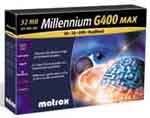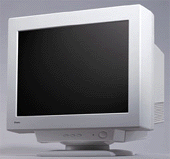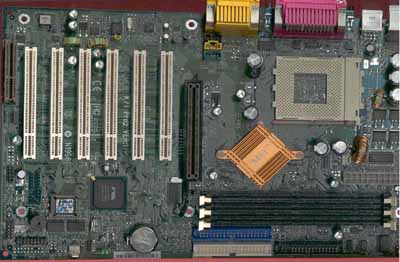Buyer's Guide: High-End Systems - December 2000
by Mike Andrawes on December 24, 2000 2:52 PM EST- Posted in
- Guides
High-end SOHO
The small office/home office machine has a unique set of requirements. It
must provide quick and snappy 2D performance and be very stable. The keys to
good performance on such a machine is lots of RAM and a fast hard drive. This
system should be able to handle just about anything a typical business user
might throw at it.
 Processor
– AMD Athlon "Thunderbird" 1.1 GHz - $250
Processor
– AMD Athlon "Thunderbird" 1.1 GHz - $250
Although CPU performance
isn’t the most important factor for many office applications, there are some
where CPU performance is critical. At similar clock speeds, the Athlon holds
a significant advantage in price, and for that reason, we’ve chosen a Socket-A
Athlon 1.1 GHz, which means that it's using the new Thunderbird core with on-die
cache. It's hard to believe we're already recommending over a 1 GHz processor
so soon, but AMD has dropped prices to the point where buying anything less
for such a machine simply doesn't make a whole lot of sense.
Besides the direct performance benefits of full speed on-die cache, we also get the side benefit of enhanced overclockability. If you're willing to overclock our CPU, you can save some money by going with the 700-800 MHz model, most of which will hit 900 - 950 MHz at default voltage, all without exotic cooling. A 900 MHz may overclock a bit better if you're lucky enough to get one with copper interconnects.
For more information on all Athlon processors, read our Athlon "Thunderbird" 1.2GHz & Duron 800 MHz Review and our Thunderbird / Duron Overclocking Guide.
Motherboard – Microstar
K7T Pro2A - $130
The availability of AMD 760 motherboards
is still non-existant for the "do it yourself" market for the time
being, so we'll have to wait at least until early next year before DDR SDRAM
systems make an appearance here. Boards using the KT133A
should be here even sooner, however, and it looks like they'll offer 90% of
the performance of DDR SDRAM using standard PC133 memory. To top it off, KT133A
boards should cost about the same as current KT133 boards since the North Bridges
are pin compatible and the same PCB layout can be used in most cases.
The VIA KT133 is here now and is the best chipset for the Athlon right now. We recently had our second KT133 Socket-A Motherboard Roundup where we looked at as many boards as we could get a hold of. Once again, one board stood out head and shoulders above the rest, but this time it was the MSI K7T Pro2 edging out the previous champ ABIT KT7-RAID. The key to overtaking the KT7-RAID was the excellent stability of the K7T Pro2, which surprassed all other KT133 boards we've tested to date, and the long awaited addition of multiplier adjustments for overclocking purposes.
The K7T Pro2A that we've chosen here is the same as the K7T Pro2 but with VIA's 686B South Bridge replacing the old 686A and thus adding Ultra ATA/100 support. Since there's no RAID support, we'll have to add an external controller, which does raise the cost a noticable amount.
The former champ, ABIT KT7-RAID, is certainly still a very good choice, as is the ASUS A7V for their solid stability and excellent feature sets, including optional on-board RAID controllers.. The EPoX EP-8KTA2, Soyo K7VTA, and FIC AZ11E are also decent choices for overclockers thanks to their multiplier controls and they'll save you a few bucks even.
For more information, read our ABIT KT7-RAID Review, ASUS A7V Review, MSI K7T Pro2 Review, and Socket-A KT133 Motherboard Roundup.
Memory – 256MB Corsair
or Mushkin CAS2 PC133 SDRAM – $200
Even though memory
is relatively cheap these days, 256MB is more than enough. We could have dropped
down to 128MB, but the savings didn’t justify the performance loss. Besides,
this is our high-end SOHO machine, and there’s room in the budget.
As for the exact brand of memory, we recommend Corsair or Mushkin modules. We use them in our test systems and have had absolutely no problems with them.
 Video
card – Matrox G400/G450 32MB Dual Head - $100
Video
card – Matrox G400/G450 32MB Dual Head - $100
We’ve always found
Matrox cards to do an excellent job in business environments, and their latest
card, the G400, is no exception. You’ll get snappy 2D display, DVD playback,
and excellent display driver utilities that include useful features like virtual
desktop. With the option for dual head, you can add a second monitor to potentially
double your workspace. And if you need to take a break from work, the G400
is ready to frag away ;)
The Matrox G450 is also an option and if you get the DDR model, the performance is virtually identical to the G400. If you just want the dual head functionality and 3D performance is not an issue, the G450 16MB SDR Dual Head version can be had for $75.
NVIDIA's GeForce2 MX features TwinView, which is functionally very similar to Matrox's Dual Head. TwinView capable boards are finally showing up on the market, but Dual Head is currently a much better solution for dual monitors than TwinView. This basically stems from the fact that TwinView is treated as two display adapters, while Matrox's drivers handle all the Dual Head options.
For more information, read our Matrox G400 & G400 MAX Review, Matrox G450 Review, and G450 Under Linux.
 Monitor
– iiYama VisionMaster PRO 450 - $450
Monitor
– iiYama VisionMaster PRO 450 - $450
If you’re going
to be sitting in front of your monitor for hours a day, it’s critical that you
have a crisp monitor that can provide a flicker-free refresh rate at your resolution
of choice. Using a Mitsubishi Diamondtron NF, the iiYama VisionMaster Pro 450
provides a perfectly flat display surface using the same technology in Sony’s
FD Trinitron models, but at a lower cost. The VisionMaster PRO 450 is a 19”
monitor and has been highly acclaimed here on AnandTech and by owners alike.
If you’ve got the funds, we highly recommend you go with the 22” VisionMaster
PRO 510 for around $900.
For more information, read our iiYama VisionMaster PRO 450 and VisionMaster PRO 510 Reviews.











0 Comments
View All Comments